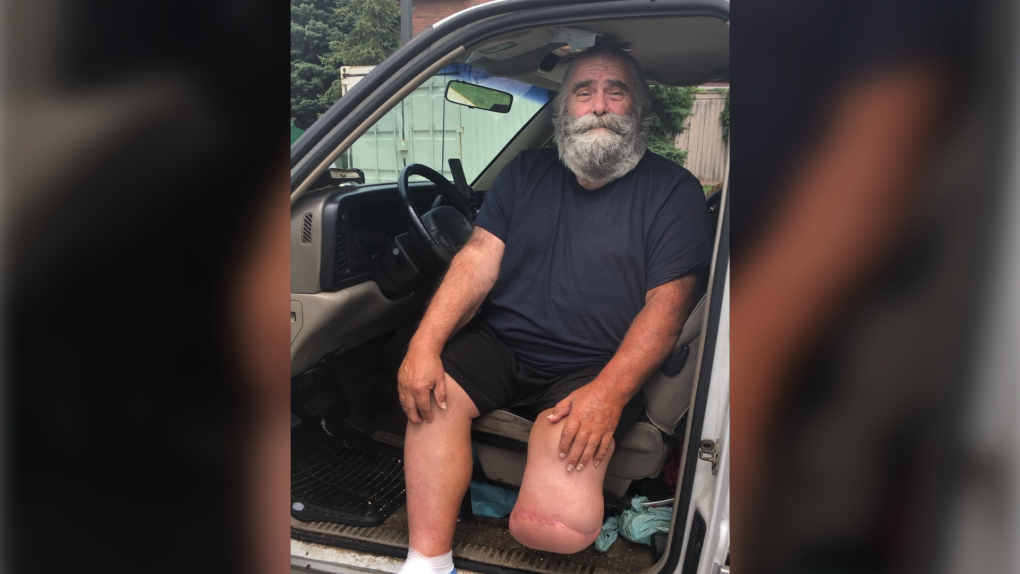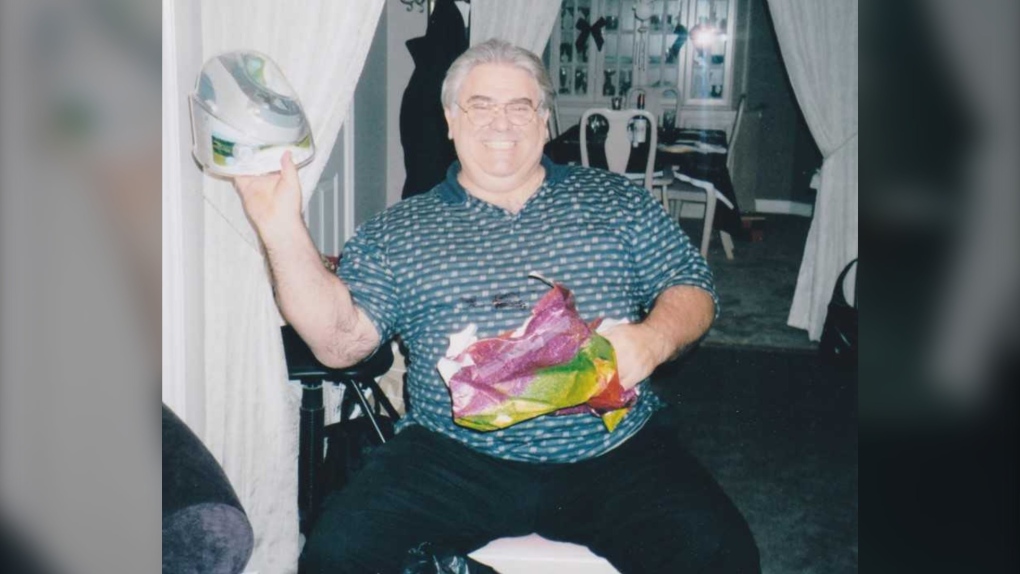Homeless Ontario amputee seeks 'financial miracle' after finding out $60K prosthetic won't be covered
An amputee living out of his car in Oakville, Ont. fears he may have to forfeit the ability to walk after finding out that the prosthetic he requires will cost him tens of thousands of dollars upfront, alongside a lifetime of maintenance expenses.
“I was in complete and utter shock,” Thomas Mohr told CTV News Toronto in an interview last week. “I paid my taxes for 52 years and I ended up like this."
- Download our app to get local alerts on your device
- Get the latest local updates right to your inbox
Mohr said he was recently told he was not a candidate for Ontario's Assistive Devices Program (ADP), a program which covers a portion of the funds needed for most prosthetic limbs, as the model he requires is too complex a fit.
To get the correct fit, he will need at least US$60,000 upfront, he says.
The problem, according to Annelise Petlock, Manager of Member Programs with The War Amps, is far more widespread than most would like to believe.
“Canadians are often shocked to learn that if they lose a limb, they'll be on the hook to pay tens of thousands of dollars out of pocket for even the most basic forms of artificial limbs,” Petlock told CTV News Toronto Tuesday.
Petlock likens the ADP to a "band-aid on a gaping wound," or a short-term solution in need of upgrading.
“There have been very few upgrades to provincial funding models in the last 20 years,” Petlock said. “It’s a really big problem.”
When reached for comment, Ontario’s Ministry of Health did not respond by the stated deadline to CTV News Toronto's questions on claims that the ADP is suffering from a lack of funding.
 Thomas Mohr can be seen above in his vehicle. (Handout by Mohr)
Thomas Mohr can be seen above in his vehicle. (Handout by Mohr)
‘NO OPTIONS OR OTHER AVENUES'
For most of his life, Mohr owned and operated a construction company in the Greater Toronto Area, but when the pandemic hit and one of his loved ones died, he said he was forced to relocate to living out of his vehicle
In late winter 2022, Mohr suffered a fall – at first, he thought nothing of it, he said – until his baby toe started “not looking right.”
He went to the emergency department and was given antibiotics. For months, he took the medicine prescribed to him and underwent additional treatments, but ultimately, the toe and surrounding area continued to suffer damage, he said.
By early summer, the wound had only gotten worse and, on July 14, he underwent an emergency amputation on his left foot, removing the limb at around the mid-point of the calf.
After weeks of rehabilitation following his surgery, Mohr said he was told that because the stump of his leg was uniquely shaped, he would not qualify for a standard prosthetic under the ADP.
“Then, they sent me on my way with no options or other avenues I knew to pursue,” he said. “I had nowhere to go, so I went to my vehicle and that’s where I am today.”
Mohr’s stump is bulbous, meaning that instead of narrowing as you move towards the stump, the leg gets wider. This is what has caused him so much trouble in finding a proper limb.
In most cases, ADP covers 75 per cent of assistive equipment required by eligible residents. The patient must pay the additional 25 per cent out of pocket when purchasing their equipment.
However, in some cases, the program doesn’t cover needed prosthetics at all – only upper and lower limb prosthetics considered to be “basic” models are eligible for coverage and in the case of motorized devices, only upper limbs can be covered.
When reached for comment, the Ministry of Health, which oversees the ADP, did not respond to questions on gaps in prosthetic coverage for Ontario residents by the stated deadline.
After learning that accessing a sufficient prosthetic was not going to be as simple as he'd envisioned, Mohr said he identified one possible option, but it would take a “financial miracle” to pull off.
‘A FINANCIAL MIRACLE’
Martin Bionics, located in Oklahoma, U.S., specializes in custom-made sockets for prosthetic limbs. It’s also one of the only facilities that can build a socket to fit Mohr, he says.
“The problem there is it's going to cost US$60,000 just for the leg and that's not the end of the story,” he said. “Every two to three years, I’m going to need adjustments and maintenance, and then, after probably about five years, you need an entirely new leg.”
‘This is going to be an ongoing cost for the rest of my life, and it's not going away,” he continued.
The only way Mohr could envision reaching his financial goal? Launching a community fundraiser. The GoFundMe, titled ‘Help Rebuild my Life After Unexpected Amputation, launched in May, has raised about $18,000 of its $1,500,000 goal.
"I've pretty much come to a standstill," he said.
Warning: The following GoFundMe link contains images that are extremely graphic in nature and that some readers may find disturbing. To view the fundraiser, click here.
While the amount may seem high, Mohr said it’s what’s needed to cover a lifetime of recurring costs.
"I have nothing else I know to do," he said.
 Thomas Mohr can be seen in a photo taken before his 2021 fall and subsequent amputation. (Handout by Mohr)
Thomas Mohr can be seen in a photo taken before his 2021 fall and subsequent amputation. (Handout by Mohr)
The high costs burdening amputees in Canada have more people turning to unorthodox means to secure their equipment, according to Petlock – a trend she called a "shame" on provincial governments.
“We see people doing things like Mr. Mohr, turning to crowdfunding to get a leg, and to The War Amps, this is a canary in the coal mine,” she said.
The GoFundMe avenue is a “stopgap” solution because it can only be accessed once when prosthetic care “is required for a lifetime,” Petlock explained.
“You don't just get one prosthesis and it's good forever – you might need another in three years or less, especially as a new amputee, when there's swelling and then physical changes,” she continued.
There’s also the cost of supplies, like sockets, that often get worn out, Petlock said. Even if maintenance costs are managed to be kept low, most people need an entirely new device every three to five years as well, she continued.
While ADP covers regular repairs on basic prosthetics, it does not cover any repairs to any damage caused by “misuse or neglect.”
“Again, I think the word here is shock – very few people have thousands of dollars and this means that someone who's suffered a devastating loss of a limb is further penalized with either ongoing debt or the loss of the ability to walk,” she said.
“It's an impossible decision but it’s a matter of independence, of dignity, and of being able to take care of yourself."
CTVNews.ca Top Stories

Can the Governor General do what Pierre Poilievre is asking? This expert says no
A historically difficult week for Prime Minister Justin Trudeau and his Liberal government ended with a renewed push from Conservative Leader Pierre Poilievre to topple this government – this time in the form a letter to the Governor General.
'I'm still thinking pinch me': lost puppy reunited with family after five years
After almost five years of searching and never giving up hope, the Tuffin family received the best Christmas gift they could have hoped for: being reunited with their long-lost puppy.
Two U.S. Navy pilots shot down over Red Sea in apparent 'friendly fire' incident, U.S. military says
Two U.S. Navy pilots were shot down Sunday over the Red Sea in an apparent 'friendly fire' incident, the U.S military said, marking the most serious incident to threaten troops in over a year of America targeting Yemen's Houthi rebels.
Big splash: Halifax mermaid waves goodbye after 16 years
Halifax's Raina the Mermaid is closing her business after 16 years in the Maritimes.
OPP find wanted man by chance in eastern Ontario home, seize $50K worth of drugs
A wanted eastern Ontario man was found with $50,000 worth of drugs and cash on him in a home in Bancroft, Ont. on Friday morning, according to the Ontario Provincial Police (OPP).
B.C. mayor gets calls from across Canada about 'crazy' plan to recruit doctors
A British Columbia community's "out-of-the-box" plan to ease its family doctor shortage by hiring physicians as city employees is sparking interest from across Canada, says Colwood Mayor Doug Kobayashi.
It was Grandma, in the cafe with a Scrabble tile: Game cafes are big holiday business
It’s the holidays, which means for many across the Prairies, there’s no better time to get locked in a dungeon with a dragon.
Oysters distributed in B.C., Alberta, Ontario recalled for norovirus contamination
The Canadian Food Inspection Agency has issued a recall due to possible norovirus contamination of certain oysters distributed in British Columbia, Alberta and Ontario.
opinion Tom Mulcair: Prime Minister Justin Trudeau's train wreck of a final act
In his latest column for CTVNews.ca, former NDP leader and political analyst Tom Mulcair puts a spotlight on the 'spectacular failure' of Prime Minister Justin Trudeau's final act on the political stage.































